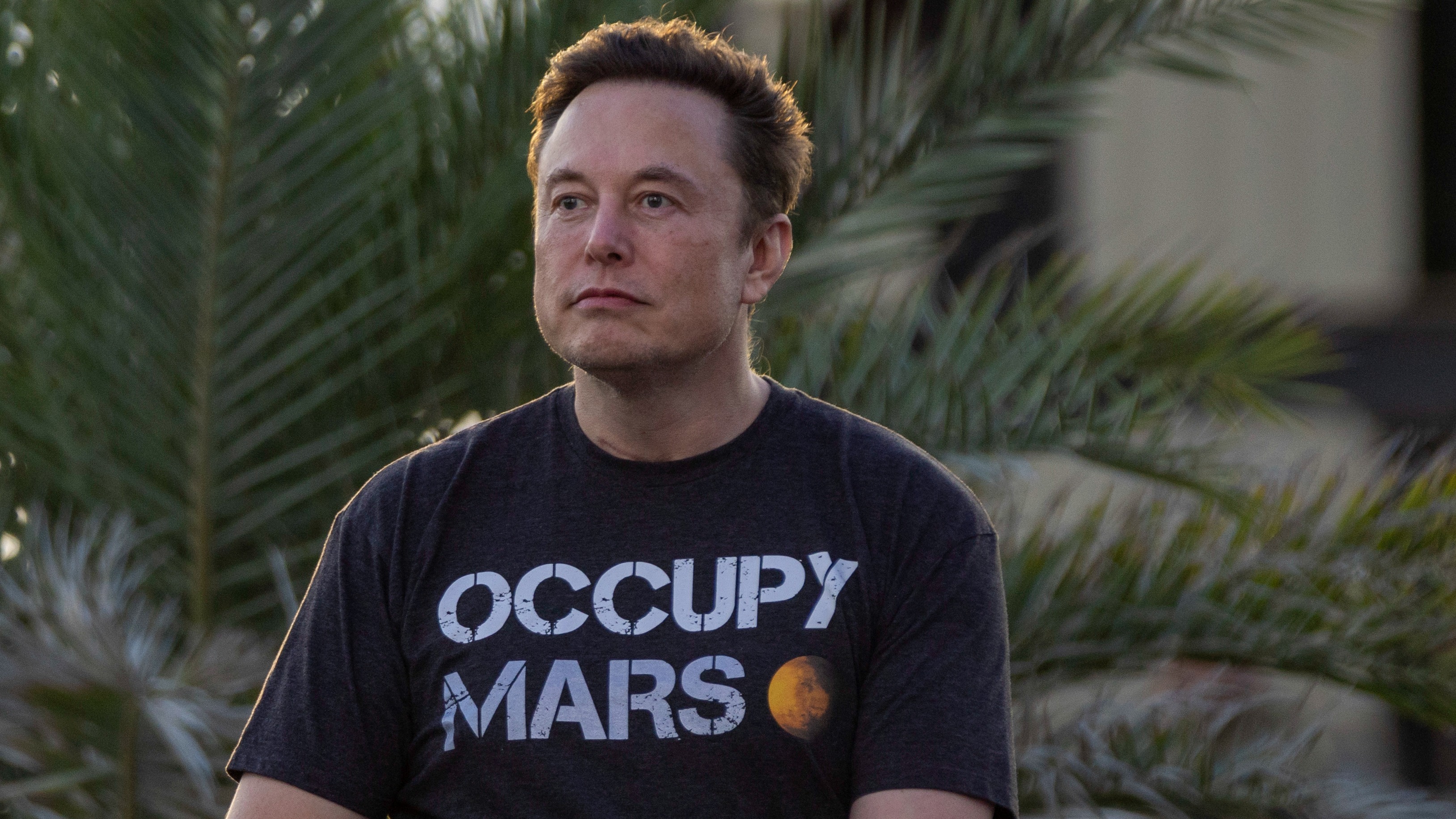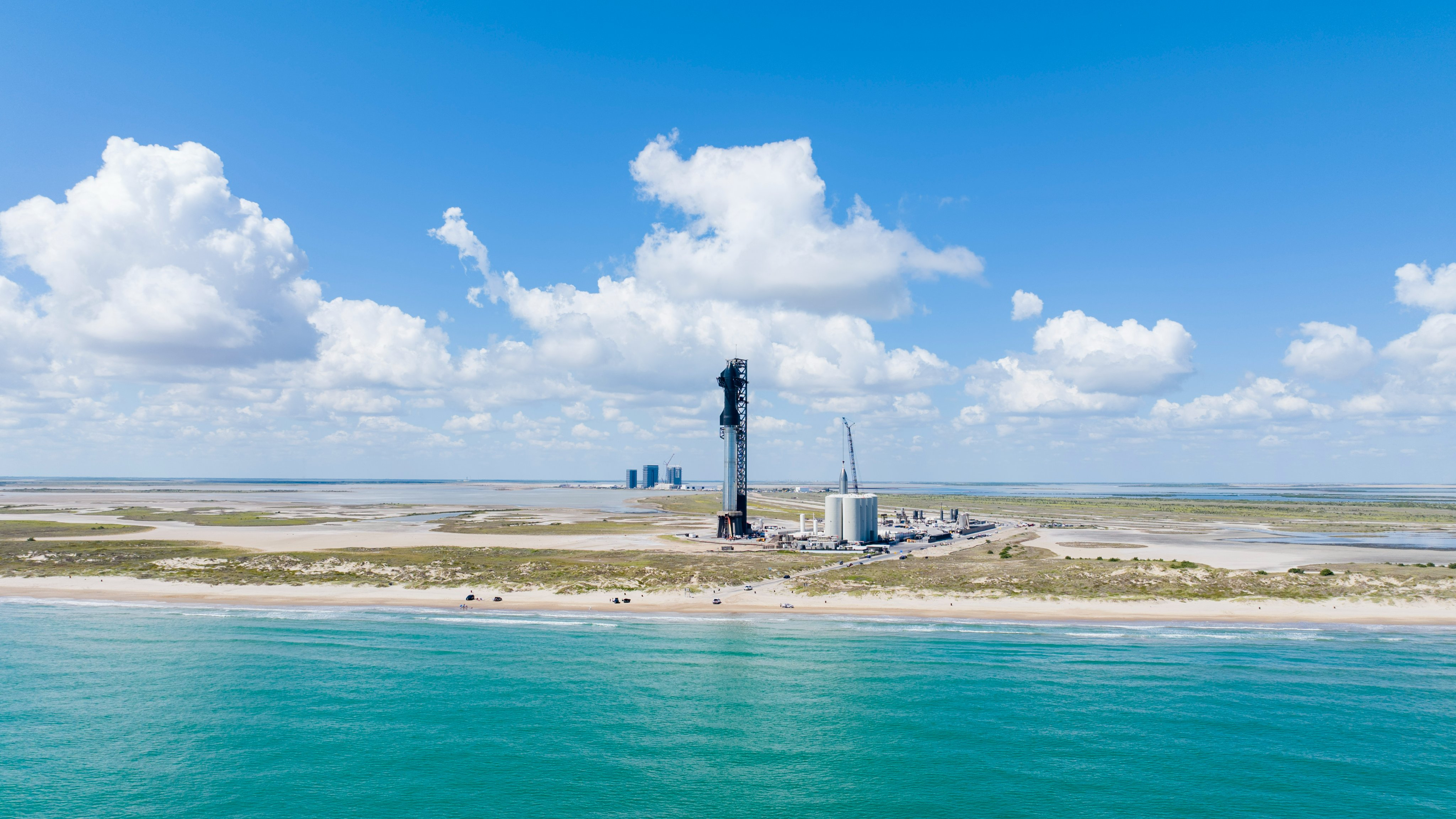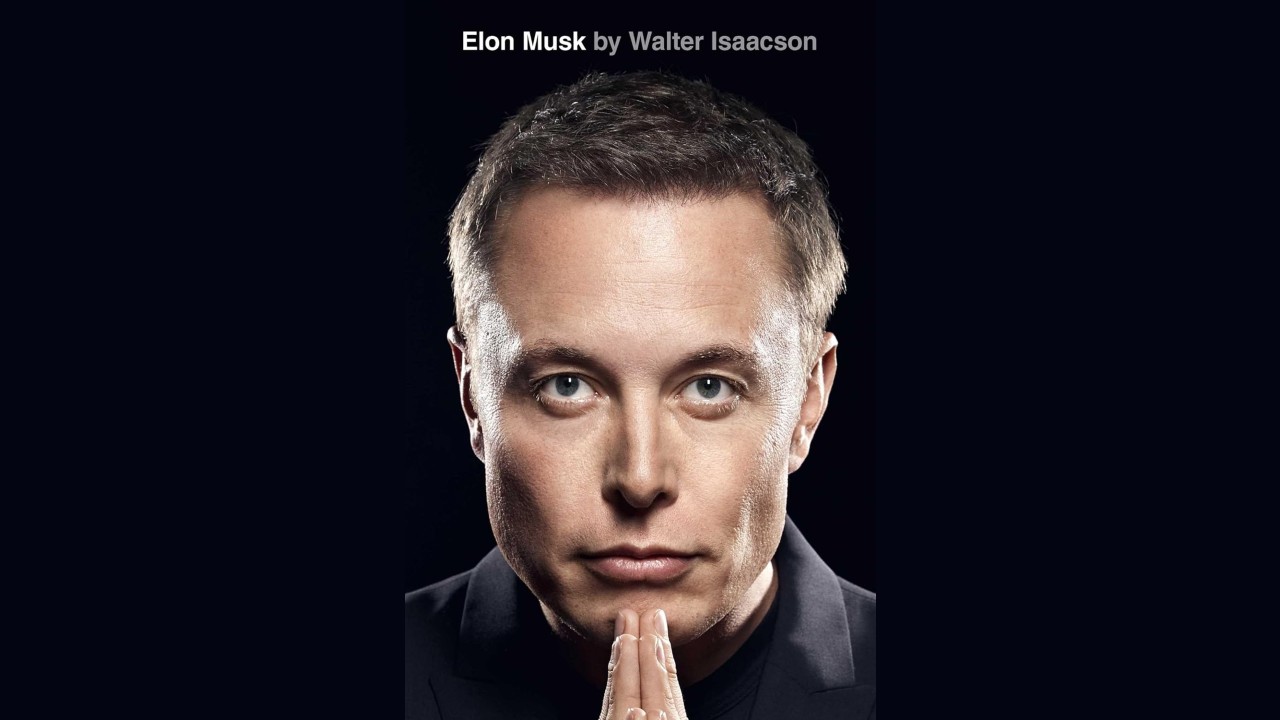SpaceX's Starship has 'decent chance' of success on upcoming flight, Elon Musk says
'If the engines light and the ship doesn't blow itself up … I think we've got a decent chance of reaching orbit.'

SpaceX CEO Elon Musk says he's hopeful Starship doesn't blow up on its second spaceflight attempt.
Elon Musk spoke about Starship, a huge SpaceX reusable rocket system aiming for a new near-orbital flight in the near future, in a keynote address on Thursday (Oct. 5) at the International Astronautical Congress (IAC) in Baku, Azerbaijan.
Speaking with moderator and Voyager Space chief revenue officer Clay Mowry, Musk said via video that SpaceX does not want to "set expectations too high" after an explosive orbital attempt in April. That effort saw Starship's two stages fail to separate, among other issues; SpaceX ultimately deliberately detonated the vehicle high above the Gulf of Mexico. Musk, 52, eventually hopes to use Starship to send people to the moon and Mars in line with his decades-long goal of reaching the Red Planet with SpaceX, which was founded in 2002.
Starship and its Super Heavy booster are the most powerful rocket system ever built, having nearly twice the liftoff thrust of NASA's Space Launch System (SLS) rocket designed for the Artemis program; SLS is the brawniest launcher currently in use until Starship is ready for operational flights.
A big contract deadline is coming, however: Starship has been tasked by NASA to land the Artemis 3 crew on the moon in 2025 or 2026 in the first such attempt by humans since Apollo 17 in 1972.
Related: SpaceX celebrated Starship's 1st launch. Some locals called it 'truly terrifying'
Delays in getting Starship ready in recent months caused NASA officials to say multiple times that they are keeping an eye on SpaceX's progress. Jim Free, the agency's associate administrator of the exploration systems development mission directorate, said in early August there is still time for SpaceX to meet NASA's Artemis 3 guidelines. But if not, he said, the agency is prepared to fly a non-landing mission for Artemis 3 and to delay the lunar touchdown to at least Artemis 4.
Get the Space.com Newsletter
Breaking space news, the latest updates on rocket launches, skywatching events and more!
We don't know when Starship will fly again. Musk said in early May that the system would be ready for a new flight in "six to eight weeks". This summer, his company also did dramatic engine fires of Starship to prepare for the next flight. But the U.S. Federal Aviation Administration (FAA) cautioned in late September that the required regulatory processes for addressing issues on the first flight is not yet complete.
While SpaceX said it has implemented all 57 actions required for the next flight and completed its investigation, the FAA has not yet awarded a license for the second launch. SpaceX also needs to receive environmental approval from the U.S. Fish and Wildlife Service, according to Reuters. Once these key items are taken care of, however, SpaceX will likely launch quickly. Musk has also said that Starship is ready to go, from a technical standpoint.
Related: SpaceX's giant Starship vehicle towers above turquoise waters in gorgeous photo

Flight 2, as Musk calls the upcoming Starship launch, will include key changes SpaceX recently implemented to Starship. For example: The company aims to "hot stage" the system, meaning that Starship will light its second-stage engines before the vehicle's two stages have fully separated.
While the Soviet Union made use of hot staging before, Musk said it's the first time SpaceX will attempt it. "I'd say that's the riskiest part of the flight," he said. "If the engines light and the ship doesn't blow itself up during staging, then I think we've got a decent chance of reaching orbit."
Presuming that happens according to plan, Starship will make less than a complete orbit of Earth and splash down in the Pacific off the coast of Hawaii, he said. The next key test in-flight will be the heat shield, so far untested.
"We think it will work, but we aren't sure if it will work," Musk said of the heat shield. "So if it doesn't work, we want it to not work over the Pacific — which is a large body of water with almost no people on it."
Related: SpaceX to launch next Starship test flight 'soon,' Elon Musk says (photos)
The current version of Starship, Musk said, produces about twice the thrust of the powerful NASA Saturn V rocket that brought Apollo program astronauts to the moon in the 1960s and 1970s. "With the upgrades that we have in the works, it'll do about three times the thrust," he said. In real terms, Starship now produces 16 million pounds of thrust at liftoff, and SpaceX is aiming for 20 million pounds in the near term, after future engine upgrades.
More changes will also come with reusability, Musk said. Pending when licenses are granted, launch tower upgrades to the access arms to catch the returning Super Heavy booster's first stage from mid-air could be available "within the next year, or maybe less than a year." As for Starship itself: "If we get lucky, we might catch the ship towards the end of next year," Musk said.
The "absurd size" of the 394-foot-tall (120 meters) Starship and Super Heavy stack supports Musk's eventual crew destination: The Red Planet. The goal is "to build something that is capable of creating a permanent base on the moon, and a city on Mars. That's why it is so large. Otherwise we can make it much smaller," he said.
Musk is aiming for a Martian touchdown without a crew "within the next four years," although he cautioned the goal was only "sort of feasible." And there's more to come after that: The propulsion system of Starship "should, to generalize, be able to land anywhere on a solid surface anywhere in the solar system," Musk said.
Dust would present one of the biggest challenges for a moon landing, but assuming Starship can handle that, only "minor modifications" would be required for destinations such as Mars, the asteroid belt, and the icy moons of Jupiter and Saturn, Musk said. He added these far-flung destinations could host propellant plants to fuel future space exploration, using resources such as water ice.

The company is also looking to reuse other elements of its space systems as much as possible, including using its Earth-orbiting broadband satellite Starlink system for laser communications at Mars, as well as recycling elements of the SpaceX spacesuit in use for astronaut missions.
Currently the spacesuit is used for the interiors of spacecraft only, but upgrades (which Musk did not specify) will allow for an extravehicular activity or spacewalk outside Starship during the Polaris Dawn mission, the first of three flights in billionaire Jared Isaacman's self-directed space program. (Isaacman is paying for these missions, in addition to Inspiration4, which flew himself and three others on SpaceX's Falcon 9 and Crew Dragon in 2021.)
Then there's also lunar rovers, which could be modified from existing cars made by Tesla, Musk's car company. "The nice thing about electric cars is that they obviously do not require oxygen," said Musk, who is also founder and CEO of Tesla. "I think Tesla could easily make a car, like a Cybertruck 'luna variant.' Just get the IP [intellectual property] or get the 'moon option' package," he said.
SpaceX will generate revenue streams for Starship development through its other missions, including periodic Starlink launches (a version 3 is expected next year), its International Space Station launches of astronauts and cargo, satellite launches for customers such as the U.S. Space Force, and (Musk disclosed) an approximately 26-foot (8 m) space telescope for the University of California, Berkeley that may itself use Starship.
This revenue is not counting other crewed launches of Starship further in the future. Isaacman plans to conclude his three-mission Polaris Program with Starship, while other billionaires and space tourists such as Yusaku Maezawa and Dennis Tito plan separate moon ventures with the system.
Related: Meet the dearMoon crew of artists, athletes and a billionaire riding SpaceX's Starship to the moon
As these people launch in the future, Musk plans to implement frequent Starship sorties from both south Texas and from SpaceX's leased Launch Pad 39A at NASA's Kennedy Space Center in Florida where Crew Dragon launches already happen. Within four or five years, he predicted, it's possible SpaceX could have a "greenfield location" for Starship at nearby Cape Canaveral (where it already launches its Falcon 9 and Falcon Heavy rockets) capable of launching several times daily.
"Then we may need to go to an ocean-based platform, just if you're launching 10 times a day. That might be a bit much even for the Cape, I don't know," he continued. "But we may end up doing platform-based launches from a specially designed sort of oceangoing platform. But we will need to do a lot of launches. We're talking about thousands of launches per year."
Musk said the incredible launch rate would be necessary to send over 100,000 tons of cargo per year to orbit, which he said is "still not quite enough" for his dreams of Mars exploration that would require "roughly a million tons" per year. (For perspective, the workhorse Falcon 9 rocket sends about 1,500 to 1,600 tons to orbit per year, which Musk said is roughly 80% of Earth's annual launching mass to orbit. He hopes to boost that to 2,500 tons next year.)
"Either we do that, or we're a single-planet species forever," Musk said. "We achieve those kinds of numbers, or we will never have a self-sustaining city on Mars."
Those who remain on Earth could perhaps use Starship in other ways, Musk hinted, such as a fast way of moving people or cargo between continents on our planet, which he suggested may work out cost-wise as Starship uses low-cost liquid methane propellant. Further cost savings may be realized from eliminating pilots (as the system would be autonomous) and even items like bathrooms, given that passengers would only need half an hour on board to get to their destination.
"It really comes down to a question of, is it economically viable compared to long-distance aircraft? And I think our back-of-the envelope numbers suggest that it actually has a shot," he said.
Join our Space Forums to keep talking space on the latest missions, night sky and more! And if you have a news tip, correction or comment, let us know at: community@space.com.

Elizabeth Howell (she/her), Ph.D., was a staff writer in the spaceflight channel between 2022 and 2024 specializing in Canadian space news. She was contributing writer for Space.com for 10 years from 2012 to 2024. Elizabeth's reporting includes multiple exclusives with the White House, leading world coverage about a lost-and-found space tomato on the International Space Station, witnessing five human spaceflight launches on two continents, flying parabolic, working inside a spacesuit, and participating in a simulated Mars mission. Her latest book, "Why Am I Taller?" (ECW Press, 2022) is co-written with astronaut Dave Williams.
-
billslugg Reply
Yes, but the N1 program was run by a madman with a substance abuse problem.Kehk in a MiG said:The N1 moon rocket also had a "decent chance" of success. -
sciencecompliance Replybillslugg said:Yes, but the N1 program was run by a madman with a substance abuse problem.
Lol. I see what you did there. -
Unclear Engineer I take that as "It has a decent chance of failing."Reply
I understand Musk's thinking about development speed being increased by getting data soon, even if it allows for many early failures.
But, unlike the U.S. early rocketry, which had many, MANY explosions on the pad and in the air, the more recent NASA work has been extremely sensitive about avoiding failures (but still has had some spectacular and even deadly ones). That is mainly driven by the funding for NASA coming from Congress, which has a short attention span compared to any engineering effort's schedule.
So, when Musk has a failure of anything, it gives his detractors a handle to argue against allowing him to continue, or at least continue at the pace that has been the hallmark of his successes.
Because his development costs are not being supported by Congressional appropriations, the only handles his opponents have on him is through government "reviews" of "safety", "environmental effects", "employment discrimination", "financial law compliance", etc. etc. These are successful in delaying, rather than directly preventing progress - until they get to the level where progress is delayed so much that it is essentially a prevention.
So, I am definitely rooting for a success, and hoping that Musk has realized that public acceptance is being tied to his ability to avoid catastrophic failures. -
sciencecompliance ReplyUnclear Engineer said:So, I am definitely rooting for a success, and hoping that Musk has realized that public acceptance is being tied to his ability to avoid catastrophic failures.
I could care less about Musk and would just as soon see him fail, but SpaceX is too important to US geopolitical goals at the moment--and employs too many decent people--to want to see it do anything but succeed, despite Musk. -
Unclear Engineer I agree that SpaceX has become too important to the U.S. and the larger "space community" to disrupt it without good reason. The problem is determining a threshold for something being a "good reason".Reply
There seem to be people who dislike Musk because they disagree with some of his beliefs or positions or opinions. And there seem to be some who just dislike anybody with a lot of money, whether they spend it on things like rockets and electric cars or gigantic personal yachts. Plus, there are always the calculating foreign interests that want to disrupt U.S. progress and use social media to create distrust and even hatred in the U.S. by leveraging the things that some people dislike.
So, when I see stuff disparaging Musk in media articles, I often wonder what the real purpose of those articles is. For instance, do those of us reading Space.com really care about Musk's personal life, or even that there are people claiming that he is "unfair" about whom he hires and whom he does not hire. Do we really care that non-citizens who have green cards might not be given a job that can be filled by a citizen? And I say that as a friend of several green card holders, some of whom have security clearances. It isn't that I don't like non-citizens. I just recognize that it costs more money and time and effort to get clearances for them, and that they might later leave the country, taking with them the knowledge that they gained about some very sensitive technologies. -
Unclear Engineer Reply
That is not what I said, so I am wondering why you took that part of my paragraph out of context and are implying that is what I meant.sciencecompliance said:If you think these are the biggest criticisms of Musk or that people are simply jealous of his wealth, then you have not been properly informed.
What I said is:
So, since you say I have not been properly informed, how about specifying what you believe are the "good reasons" to "disrupt" SpaceX activities? Remember, we are talking about disrupting launch capabilities, present and future. So, let's not drag in the things that are related to his other companies, or his private life, or even his personal opinions about world events.Unclear Engineer said:I agree that SpaceX has become too important to the U.S. and the larger "space community" to disrupt it without good reason. The problem is determining a threshold for something being a "good reason". -
billslugg "the fact that he regularly lies " - sciencecomplianceReply
Google "Top Musk Lies"
Go to the first item on the search results
Open the list and go to the first item
Tab down to the "money quote", here it is:
"Musk replied to Insider by saying there’s “a lot more to this story” and asked the outlet for more time to respond. Insider agreed and extended its deadline. But instead of following up with Insider, Musk took to Twitter to announce he’d be voting Republican and predicted Democrats would engage in “dirty tricks” against him."
The top Musk lie: He promised to call a reporter back, and didn't.
Go to the second web site on the search results
"Talking Up Hyperloop, the (Fantasy) Transportation of the Future"
It seems in 2013 he said in a funding proposal that "a pod would be able to whisk passengers from L.A. to San Francisco in just 35 minutes.", and that never happened.
Top Musk lie: He talked something up and failed to deliver. "He did it only to derail the high speed train." Or, it could be he lost interest, or he needed money somewhere else, or the permits were hard to get, or he woke up to the cesspool that CA has become and wanted nothing to do with it. So, who is lying here?
That is the best they have. Anyone got a better example? We'll add it to the list. -
billslugg "Elon Musk wins defamation case over 'pedo guy' tweet about caver"PublishedReply
6 December 2019
BBC









